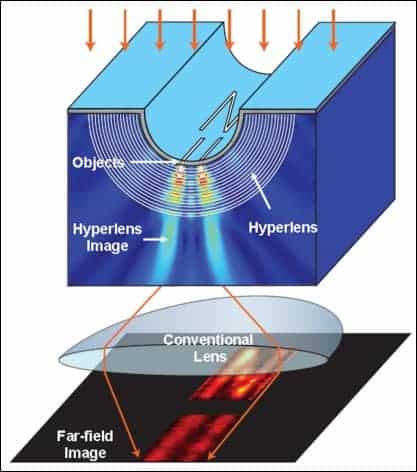Two teams of physicists from the US have independently created the first truly magnifying "superlenses" using metamaterials with a negative index of refraction. Unlike conventional lenses, superlenses can provide images of almost limitless resolution, and could one day enable the optical imaging of proteins, viruses and DNA.

No matter how smooth and polished a conventional lens is, there will always be a finite amount of detail it can reproduce. This is because light tends to diffract, and so prevents resolution of features much smaller than its wavelength – what physicists refer to as the “diffraction limit”. However, this limit can be surpassed if one can find a way of collecting the idle “evanescent” waves that exist close to the surface of an object. These waves can resolve surface features much smaller than normal propagating waves, but decay too quickly for conventional lenses to capture.
In 2000, John Pendry of Imperial College in London predicted that the decay of evanescent waves can be offset by amplifying them in a material with a negative refractive index – in other words, one that bends incoming light in the opposite direction to an ordinary material. In theory, such a negative-index “superlens” could take evanescent waves from a surface, carry them, and convert them into propagating waves that travel far enough to be captured by a conventional microscope after they leave. Since Pendry’s prediction, several superlenses have been built that have successfully transmitted evanescent waves. However, none has been able to make the crucial conversion to propagating waves – leaving the evanescent waves with the same fast decay rate as when they started.
Now, two groups have managed to create superlenses that can convert evanescent waves into propagating waves. At the University of Maryland, a team led by Igor Smolyanivov has created a flat superlens consisting of concentric polymer rings deposited onto a thin film of gold (Science 315 1699). Meanwhile, a team led by Xiang Zhang at the University of California in Berkeley has opted for a 3D stack of curved silver and aluminium-oxide layers on a quartz substrate (Science 315 1686).
Both of these designs are classified as “metamaterials” – artificial nanostructures made by physicists because substances with a negative index in the optical range do not occur naturally. Superlenses have been made from metamaterials before, but the cylindrical geometry of these new designs enables evanescent waves emitted from illuminated objects to be guided outward. Because momentum must be conserved, this separation forces the “tangential” or side-to-side momentum of the waves to be compressed, resulting in a magnified image beyond the diffraction limit – one that a conventional microscope can register.
Smolyanivov used his flat superlens to image rows of polymer dots deposited near the inner ring with a resolution of 70 nm – seven times better than the diffraction limit of the illuminating laser. Zhang, however, took his 3D superlens (or “hyperlens” as he prefers because of the hyperbolic shape) one step farther and imaged the word “ON” inscribed on the surface, albeit with a slightly lower resolution of 130 nm.
Although both of these superlenses imaged objects that were “built-in” to the material, in practice one would keep an object separate but still close enough so that the evanescent waves can be captured. Even so, Smolyanivov told Physics Web that widespread applications may be some way off. This is because a side effect of the increased resolution is the vastly reduced depth of field, meaning focusing must be much more accurate. “The real challenge will be to locate a sample”, he said. “You won’t be able to see it if it’s out of focus.”




